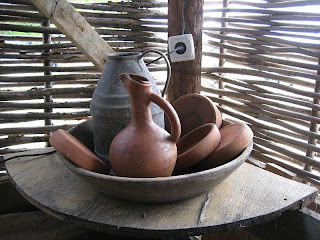 |
| "Mother Georgia." |
Preface
Some Georgian women are very strong.
"Strong" is a Georgian euphemism for "I know what you should want, and the sooner you accept that, the sooner I'll be back smiling and we all know what happens when I'm not smiling, don't we ....?"
A colleague called me and asked if I'd like to participate in a trip to Svaneti. Would I?! Hell, yes!! She explained we'd take the night train from Tbilisi to point A, then a six-hour marshrutka ride to Svaneti, and stay at a lodge. We'd go the end of September to beat the snow because once the snow flew, the roads might be closed until spring.
Several days later
My colleague called me again. Great news! A Georgian colleague had a connection with a tour company and she was excited to arrange everything for us! Marshrutka from Tbilisi to Svaneti! Lodging! Meals! English guide up into the mountains! A picnic lunch alongside a lake! Svardi cooked over an open fire up in the mountain pass! All for 150 lari for the weekend!
Wow. My cup runneth over. The legendary Svaneti!
A day or so later
My colleague called again. By the way, it wasn't a problem, was it, that our destination wasn't quite Svaneti ... it was actually Svaneti-Racha? We'd be visiting the highest village in all of Europe. The area was just as beautiful as Svaneti, really, and was unfairly ignored by tourists.
Sure! Sounds fantastic! Svaneti-Racha is almost like Svaneti!
A few days before the trip
The village "Oni" will be rainy and cold, so dress accordingly. Oni? I didn't remember seeing the name of that village when I googled on highest village in Europe. I was thinking Ushguli. Oh well, no mind. Svaneti-Racha!
The big day
We met at 7:00 a.m. in Tbilisi in front of the Radisson Hotel near Rustaveli Square. And that's where I met my colleague's colleague. Mariami. A strong Georgian woman.
And somewhere along the way on this Friday, I learned that Svaneti did not enter the equation at all. Racha was our destination.
It was rainy. Cold. Cloudy. Gray.
The marshrutka seats were jammed together so tightly that even though I have short legs, my knees scrunched against the seat in front of me.
Another colleague, Sandy, lives in Gori. Mariami and the tour company had kindly agreed to pick her up "outside" of Gori, saving Sandy a one-hour trip to Tbilisi the night before. The only catch was - where exactly was "outside" Gori?
Sandy and I had been told the answer would be revealed the morning of our departure, thus when, on the marshrutka, I asked Mariami about picking up Sandy, she said, "Yes, we will now call Sandy to let her know we are leaving Tbilisi."
"But she doesn't know where you will be picking her up yet."
"Don't worry, we have been doing this for a very long time. We have done this many times."
"Yes, but Sandy has never done this and she doesn't know where to go."
With some exasperation, Mariami had our learned tour guide, David (degrees in physics, history, and music - a former violinist in the symphony) call Sandy to let her know we'd pick her up "on the highway by Gori" in about an hour. Sandy and I were given to understand that somehow the precise location would become known to Sandy.
I surrendered to the higher power upon the marshrutka, at least for a time. But as the kilometers ticked under us, I began to look for a sign about the upcoming distance to Gori, figuring to give Sandy a heads-up. When some distance passed and I didn't see any signage, I asked David how much farther to Gori, so I could give Sandy a call.
"Oh, I will call her when we are 15 minutes away. Then I'll talk to the taxi driver who will take her to the pick-up point."
"Taxi driver? What taxi driver?"
It all ended up quite beautifully - we swung by and picked Sandy up at her flat in Gori. Georgian hospitality triumphed.
So on we went on this dreary day in which there were no mountains to be seen due to oppressive cloud cover.
Mariami, that strong Georgian woman, was valiant in her determination for us to enjoy this gray day. No sun? No lake to picnic by? Not a problem! We "picnicked" at a roadside picnic table under a blue tarp, all of us standing, shivering with cold and wetness, while Mariami and her colleagues unpacked lunch from boxes. And you know what? Mariami had made everything herself - the potato latkes, the khachapuri, the sweet cakes, and even the cognac. And they were good, dammit, even through the wretched conditions.
After some of us revolted at the idea of slip-sliding down a rocky, wet path to the outhouse (myself included), we got back on the bus after lunch, and were delivered to a nicer service-station WC.
We continued our journey to the most-beautiful-place-in-Georgia-that-is-not-Svaneti-goddamit-it, which looked not undifferent from Colorado in mining-town regions, by which I mean to say, I felt a little discouraged, despite the good company on the marshrutka.
We stopped at a couple of churches. Georgian churches are nice. They look especially picturesque from a distance. Close up, most are less prepossessing. Almost all have the same architectural design.
The really old churches have had their iconography stripped by various tides of invading barbarians.
What entrances me the most right now are the Georgian cemeteries. Must explore more of these.
The photos below show a collection from two churches, one cemetery, and one synagogue in Racha.
Next: Part 2, We're Going to Need Another Turkish Toilet

















































